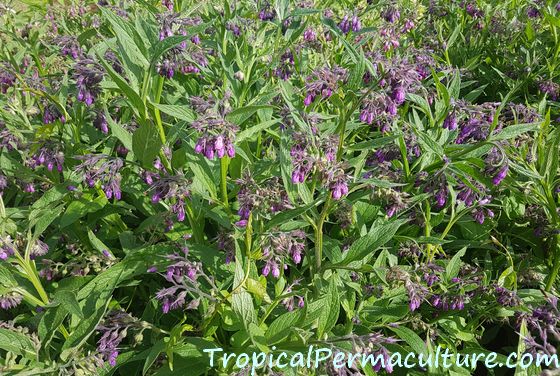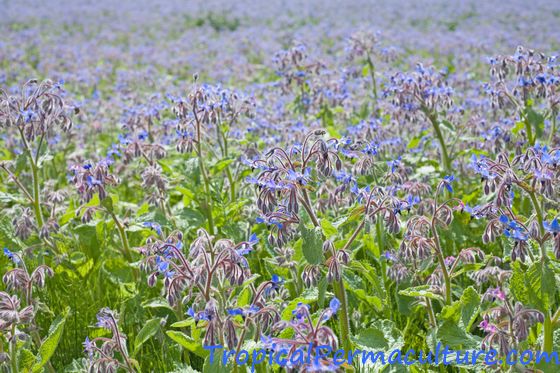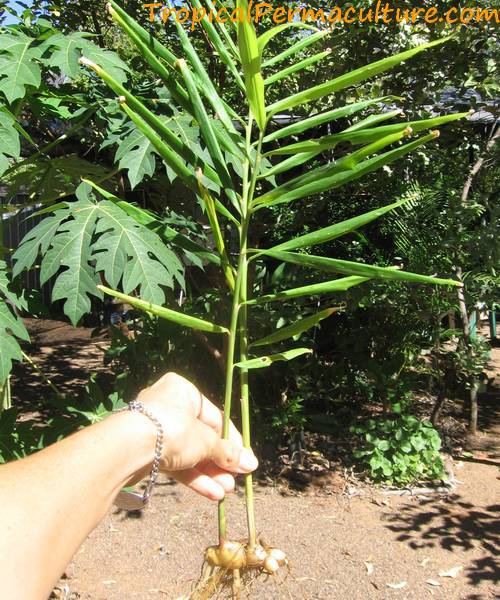Growing Basil (Ocimum basilicum)
How To Grow Basil In Different Climates
Thankfully growing basil is super easy in warm climates. At least that's my experience. It's not what I expected since all other Mediterranean herbs struggle with our humid, tropical wet seasons (summers), but basil doesn't care.
Back in the days when I did not have a clue about how to grow ANYTHING, basil was the one thing that did grow. Without fail. All year round. Like a weed.
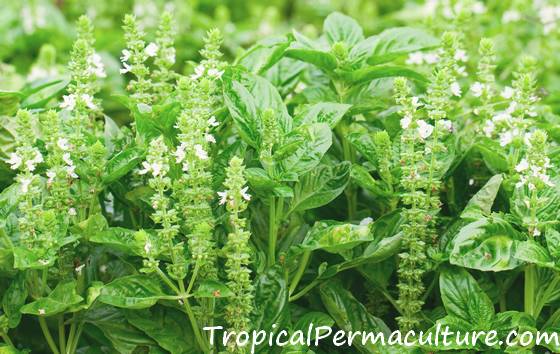
Once I learned more about growing different food plants, herbs and spices, I learned that basil is not strictly a Mediterranean herb. Most of us know and grow sweet basil as an essential ingredient for Italian dishes. However, many other basil varieties exist (cinnamon basil, lemon basil, Thai basil, purple ruffles, holy basil...) and they are just as essential in Asian cooking.
Well, and Asian climates with their steamy monsoonal summers are similar to my climate in northern Australia. That's why basil is so happy in my garden.
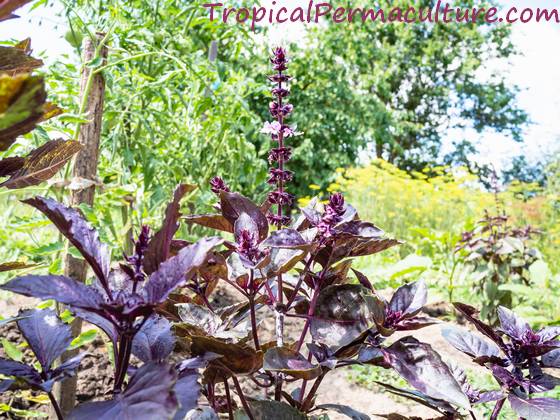 Purple basil
Purple basil
Not everybody lives in a tropical climate, so on this page we will look at what it takes to grow basil, no matter what your climate.
Growing basil at home has many benefits.
- Basil is a wonderful culinary herb. Tomatoes and sweet basil are made for each other, pesto is something I could eat every day, and a green curry without Thai basil just wouldn't be a green curry, would it?
- Basil is also used as a medicinal herb. (The different types of basil have different traditional uses.)
- Basil supposedly repels flies. (In my experience that is a lie.)
- Basil repels fruit fly. (It's not a fail proof solution but it definitely helps.)
- Basil does have a strong scent. It is pleasant to grow just for the scent it emits when you brush it as you walk through your garden. But even better, the scent also confuses bugs that find their favourite plants by smell.
- Sweet basil and tomatoes are perfect companion plants, in the garden AND in the kitchen.
- Bees love the flowers and the flowers look pretty in the garden, too.
- Basil itself looks pretty, too. The mauve flower spikes of cinnamon basil, the deep purple leaves of opal basil, the compact purple balls of flowers on my Thai basil...
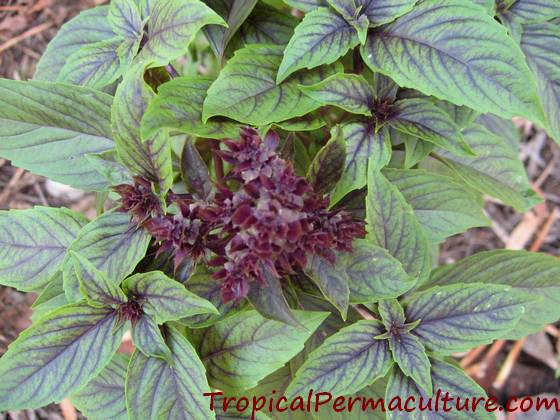
Where Can You Grow Basil?
You can grow basil just about anywhere, though not necessarily all year round.
Basil loves hot weather, lots of sunlight, lots of nutrients i.e. rich soil, lots of water and lots of space for its roots.
Basil has a very vigorous root system. If you grow basil in the garden then the basil roots will go and find what the plant needs. So even if the soil is not so great, you can still grow basil. It also copes with little water and even grows in partial shade. It will however have more flavour if grown in full sun.
Basil does not like water logging and will not survive frost. Established plants can handle cool spells, but to get basil seeds started it needs to be hot.
In the tropics, sweet basil grows best during the dry season. It also likes Mediterranean climates.
If you live in a temperate climate, you can germinate and grow basil seeds indoors, even in winter. But because of the lack of sunlight during winter they will not grow into big, healthy plants. You best harvest them very early and germinate more. Or move to a warmer climate.
In a warm climate you can grow basil all year round, in any type of soil. It may not grow equally well in all soils, but it should grow.
Get Started With Growing Basil
There are two ways to grow basil: from seed or from cuttings. Both work well and I use both all the time.
It's best to grow sweet basil from seed as an annual.
All other basil types are perennials. They are also called bush basil. Perennial basil is easier to grow from cuttings.
All the perennial basils do great in the true tropics all year round. In cooler climates you will need to treat them as annual plants and grow them during summer.
Growing basil from seed:
Basil seed is very fine and can take weeks to germinate. If you throw it straight on the ground in your garden the weeds may smother it before it has a chance to grow, so you may want to start it in punnets or pots.
Punnets will make the transplanting easier but require more faffing around in the beginning, filling all the individual slots with soil and counting out the tiny seeds. That's why I use pots and start enough seeds to allow for some losses.
Spread some seed very thinly and only cover it with soil very lightly.
Start out with moist soil, so you don't have to add a lot of water afterwards. Watering your pots or punnets can make the light soil covering and the seeds float around and you end up with all your seeds in one spot at the side... If you need to add some moisture you can use a spray bottle.
Once you are done, keep the pot in a sunny, warm place and do not let it dry out. A plastic cover can help.
How long it takes for your seeds to germinate depends on the soil temperature. It could be 3-5 days or a couple of weeks.
If you used a cover over your pot or punnet, remove it immediately as soon as you see the first seedling emerge. Basil seedlings are very vulnerable to fungal diseases at that stage, so you want to make sure the air can circulate and the soil surface retains an even moisture, not too wet but also never dry.
(A good way to avoid problems is to water from the bottom, by placing the pot in a bowl with some water for a few minutes.)
Initially your basil will grow very slowly. It will take about 4-6 weeks (depends on the temperature and the amount of sunlight it gets) until it is big enough to plant it out, about 15 cm/6 inches tall.
Don't wait with the transplanting. Basil grows much better and faster in the ground, so the sooner it goes outside, the sooner you will be harvesting.
A Word Of Warning
I do not recommend buying basil seedlings in pots. As I already mentioned above, young basil plants are very vulnerable to fungal diseases, particularly a process called "damping off", where the little plants wilt and rot from the bottom.
Most of the pots of little basil plants that you see for sale have way too many seedlings crowded together to allow the air to circulate freely between them.
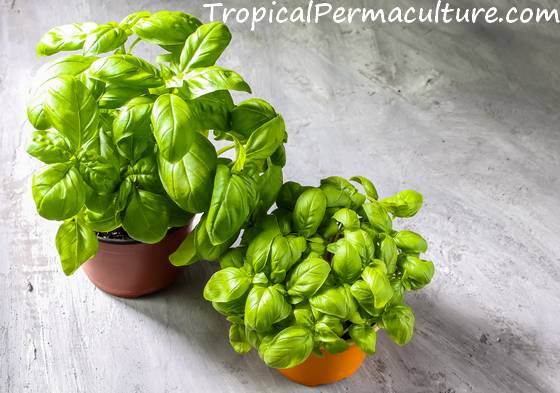 You do not want your seedlings to grow like this!
You do not want your seedlings to grow like this!Unless it is a quality nursery, the plants will also be watered irregularly, something that encourages damping off.
Those herbs in pots that you get at many supermarkets or grocery stores are really only meant to be cut and eaten fairly quickly, not to be grown for an extended time.
You can grow your own seed the same way if you plan to eat it as soon as the plants are 15-20 cm (6-8 inches) tall, for example when growing it indoors during the cooler time of the year. But if you start seedlings that you want to grow into big plants in the garden, then give them enough space right from the start.
Growing basil from cuttings:
If you live in a warm climate, just take a tip cutting off any plant at any time of the year. Cut off all the leaves except for the tiny ones that are emerging at the top and stick the thing in a pot. Keep it in partial shade and keep it moist. Basil cuttings root very quickly. Once the little basil plant is actively growing again you can plant it out.
Cuttings are not so susceptible to fungal problems, so you don't need all the precautions that you need to take with seedlings in the early stages.
Growing And Using Basil.
Whether you use cuttings or seedlings, plant them out as soon as they are big enough to handle. (If you want to grow basil in containers, use the biggest container possible!)
Select a sunny position. Ideally you put basil together with plants that have similar requirements, i.e. that need a lot of water and nutrients. And then give your plants a lot of water an nutrients. Make sure they are always well watered and well fed, and your basil plants will grow into huge bushes in no time!
You can start harvesting basil very early. In fact, you should. Basil should be picked constantly.
You can harvest individual leaves, but the best way to harvest basil is to take off all the tips. Start doing this when your basil is about 15 cm high. It encourages more branching and more growth, but most importantly it prevents flowering.
That's right. Unfortunately, if you have only a few plants, you should prevent your basil plants from flowering for as long as possible. Once a basil plant goes to flower it puts all its energy into the blooms and seeds and does not produce any more leaves. And then it dies.
So, don't let basil flower.
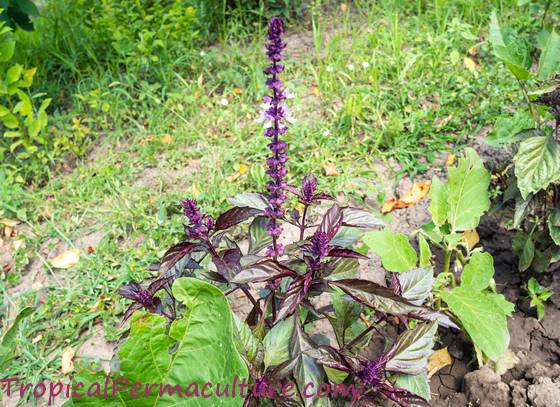 Too late!
Too late!
If you need a lot of basil, for example for making pesto, you can just go at your bushes with a big pair of scissors and give them a good hair cut. That's the easiest way. If you need just a few shoots to flavour a curry you can pull off the tips with your fingers or any cutters. If there are some young flower buds in your harvest that's not a problem. They are edible and taste no different.
Basil Growing Tips
Most of our culinary herbs taste best when you treat them harshly. They lose flavour if you pamper them. Not basil.
You can't feed basil too much. It will use everything you can throw at it and then ask for more. (Compost, compost tea, chook poo, fish fertiliser, mulch, anything...) Basil tastes best if well fed. If you want your basil to keep growing and producing leaves, keep feeding it.
That also means that the best place to grow your basil is NOT together with herbs like rosemary, oregano, thyme etc. Those herbs need drier conditions and don't like a lot of nitrogen. Yes, they go well together with basil in the kitchen but not in the garden.
As I already mentioned, basil is very aggressive about getting what it wants. It is also fast growing, so only plant it together with other vigorous plants that can hold their own against it. A well fed, mature sweet basil bush can easily measure three feet high and across. And the bush basils are not far behind.
Basil is indeed a good companion plant for tomatoes. The two have the same growing requirements, are both vigorous plants, and grow to about the same size. Plant seeds at the same time and the two should get along splendidly.
Also try growing basil under other fruiting plants that are prone to bug damage. It seems the strong scent either confuses the bugs or repels them.
If you have a reasonably sized garden in a warm climate, then growing basil requires hardly any work at all once you get a few plants going. Yes, basil plants die once they flower, but they also produce seed which falls to the ground and germinates again. There is always some basil somewhere.
The only problem with the self seeding is that the different basil varieties cross breed. To keep some pure plants just take cuttings every now and then.
Growing Basil In My Permaculture Garden
I have several bushes of basil just outside my kitchen door. (As in any good permaculture design the herbs and spices that I use on a regular basis grow right at my kitchen door.) When I cook I only need to take a few steps to get fresh basil.
I regularly take one or two cuttings of the mature basil plants and plant them right there. It's not a scientific operation. I just pinch off a tip, pull off the leaves and stick it in the ground. I may throw some very loose, light mulch over it to protect it a bit. Most of those basil cuttings grow despite the rough treatment.
Once the old basil plant looks a bit sickly, and eventually it will, I cut it and mulch it in place. This way I always have a few young and productive plants of each basil species right there.
In the rest of my permaculture garden the basil roams wild. It cross breeds and self seeds and comes up everywhere, and it flowers and is full of bees and butterflies and is absolutely beautiful.
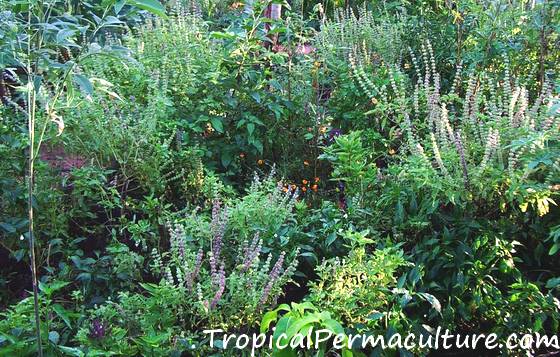 Basil flower spikes everywhere.
Basil flower spikes everywhere.
Oh, and I get carried away and use basil flowers as cut flowers. The white and purple spikes are gorgeous and I love the scent.
If I see basil plants growing in an unsuitable place, I pull them up. If I want to grow a new patch of basil somewhere, be it for pest control purposes or to enjoy the scent or just for looks, then I cut some dry flower spikes of an old plant, rub them and crunch them up between my hands, and throw them over the soil where I want the basil to grow. That's it.
Growing basil isn't hard, is it?
